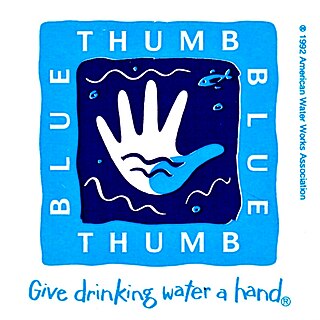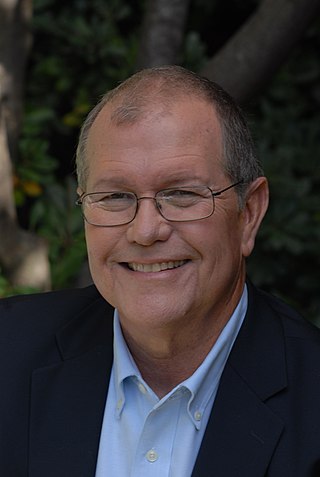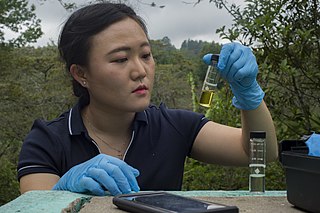
Chlorine is a chemical element; it has symbol Cl and atomic number 17. The second-lightest of the halogens, it appears between fluorine and bromine in the periodic table and its properties are mostly intermediate between them. Chlorine is a yellow-green gas at room temperature. It is an extremely reactive element and a strong oxidising agent: among the elements, it has the highest electron affinity and the third-highest electronegativity on the revised Pauling scale, behind only oxygen and fluorine.

Sodium hypochlorite is an alkaline inorganic chemical compound with the formula NaOCl. It is commonly known in a dilute aqueous solution as bleach or chlorine bleach. It is the sodium salt of hypochlorous acid, consisting of sodium cations and hypochlorite anions.
Water purification is the process of removing undesirable chemicals, biological contaminants, suspended solids, and gases from water. The goal is to produce water that is fit for specific purposes. Most water is purified and disinfected for human consumption, but water purification may also be carried out for a variety of other purposes, including medical, pharmacological, chemical, and industrial applications. The history of water purification includes a wide variety of methods. The methods used include physical processes such as filtration, sedimentation, and distillation; biological processes such as slow sand filters or biologically active carbon; chemical processes such as flocculation and chlorination; and the use of electromagnetic radiation such as ultraviolet light.

Chlorine dioxide is a chemical compound with the formula ClO2 that exists as yellowish-green gas above 11 °C, a reddish-brown liquid between 11 °C and −59 °C, and as bright orange crystals below −59 °C. It is usually handled as an aqueous solution. It is commonly used as a bleach. More recent developments have extended its applications in food processing and as a disinfectant.

American Water Works Association (AWWA) is an international non-profit, scientific and educational association founded to improve water quality and supply. Established in 1881, it is a lobbying organization representing a membership of around 50,000 members worldwide.
Monochloramine, often called chloramine, is the chemical compound with the formula NH2Cl. Together with dichloramine (NHCl2) and nitrogen trichloride (NCl3), it is one of the three chloramines of ammonia. It is a colorless liquid at its melting point of −66 °C (−87 °F), but it is usually handled as a dilute aqueous solution, in which form it is sometimes used as a disinfectant. Chloramine is too unstable to have its boiling point measured.

Bleach is the generic name for any chemical product that is used industrially or domestically to remove color from fabric or fiber or to disinfect after cleaning. It often refers specifically to a dilute solution of sodium hypochlorite, also called "liquid bleach".
Disinfection by-products (DBPs) are organic and inorganic compounds resulting from chemical reactions between organic and inorganic substances such as contaminates and chemical treatment disinfection agents, respectively, in water during water disinfection processes.

Copper-silver ionization is a disinfection process, primarily used to control Legionella, the bacteria responsible for Legionnaires' disease. There is strong evidence that treating water supplies in hospitals with this technique decreases the risk.

George Warren Fuller was an American sanitary engineer who was also trained in bacteriology and chemistry. His career extended from 1890 to 1934 and he was responsible for important innovations in water and wastewater treatment. He designed and built the first modern water filtration plant, and he designed and built the first chlorination system that disinfected a U.S. drinking water supply. In addition, he performed groundbreaking engineering work on sewage treatment facilities in the U.S. He was President of both the American Water Works Association and the American Public Health Association, and he was recognized internationally as an expert civil and sanitary engineer.

John Laing Leal was an American physician and water treatment expert who, in 1908, was responsible for conceiving and implementing the first disinfection of a U.S. drinking water supply using chlorine. He was one of the principal expert witnesses at two trials which examined the quality of the water supply in Jersey City, New Jersey, and which evaluated the safety and utility of chlorine for production of "pure and wholesome" drinking water. The second trial verdict approved the use of chlorine to disinfect drinking water which led to an explosion of its use in water supplies across the U.S.

George Chandler Whipple was an American civil engineer and an expert in the field of sanitary microbiology. His career extended from 1889 to 1924 and he is best known as a co-founder of the Harvard School of Public Health. Whipple published some of the most important books in the early history of public health and applied microbiology.

Michael John McGuire is an American environmental engineer, laboratory director and writer whose career has focused on drinking water quality improvement. He has been recognized for his expertise in the control of trace organic compounds, inorganic contaminants and microbial pathogens in water. He is also known for his work in the identification, control and treatment of taste and odor problems in drinking water. McGuire combined the development of taste and odor analytical methods along with in situ treatment and oxidation. He developed a solution to the Metropolitan Water District of Southern California's problem with trihalomethanes using ozone, PEROXONE and chloramines. He has published numerous articles in professional journals and he has been the co-editor of five books and compilations of articles. He published a book that documented the first continuous disinfection of a drinking water supply in the U.S. With Marie S. Pearthree, he wrote a book on the corrosive water debacle in Tucson, Arizona in 1992–94. He has been active in the American Water Works Association, and he has served as a volunteer and officer in that organization. In 2009, he was elected to the National Academy of Engineering.

Edward Bartow was an American chemist and an expert in the field of sanitary chemistry. His career extended from 1897 to 1958 and he is best known for his work in drinking water purification and wastewater treatment. He was well known as an educator, and his many students went on to leadership positions in the fields of sanitary chemistry and engineering.
John Robert Baylis was an American chemist and sanitary engineer. His career extended from about 1905 to 1963 and he is best known for his work in applied research to improve drinking water purification.
Earle Bernard Phelps was a chemist, bacteriologist and sanitary expert who served in governmental positions and as an academic in some of the leading universities in the U.S. He is known for his contributions in sewage disinfection, water chlorination, sewage treatment, milk pasteurization, shellfish control, and for describing the “oxygen sag curve” in surface water bodies.

Water chlorination is the process of adding chlorine or chlorine compounds such as sodium hypochlorite to water. This method is used to kill bacteria, viruses and other microbes in water. In particular, chlorination is used to prevent the spread of waterborne diseases such as cholera, dysentery, and typhoid.
A mixed oxidant solution (MOS) is a type of disinfectant that has many uses including disinfecting, sterilizing, and eliminating pathogenic microorganisms in water. An MOS may have advantages such as a higher disinfecting power, stable residual chlorine in water, elimination of biofilm, and safety. The main components of an MOS are chlorine and its derivatives, which are produced by electrolysis of sodium chloride. It may also contain high amounts of hydroxy radicals, chlorine dioxide, dissolved ozone, hydrogen peroxide and oxygen from which the name "mixed oxidant" is derived.

Chlorine-releasing compounds, also known as chlorine base compounds, is jargon to describe certain chlorine-containing substances that are used as disinfectants and bleaches. They include the following chemicals: sodium hypochlorite, chloramine, halazone, and sodium dichloroisocyanurate. They are widely used to disinfect water and medical equipment, and surface areas as well as bleaching materials such as cloth. The presence of organic matter can make them less effective as disinfectants. They come as a liquid solution, or as a powder that is mixed with water before use.

Stuart William Krasner, was the Principal Environmental Specialist (retired) with the Metropolitan Water District of Southern California, at the Water Quality Laboratory located in La Verne, California. In his 41 years with Metropolitan, he made revolutionary changes in the field's understanding of how disinfection by-products occur, are formed and how they can be controlled in drinking water. His research contributions include the study of emerging DBPs including those associated with chlorine, chloramines, ozone, chlorine dioxide and bromide/iodide-containing waters. He made groundbreaking advances in understanding the watershed sources of pharmaceuticals and personal care products (PPCPs) and wastewater impacts on drinking-water supplies. For DBPs and PPCPs, he developed analytical methods and occurrence data and he provided technical expertise for the development of regulations for these drinking water contaminants. In the early 1990s, Krasner developed the 3x3 matrix illustrating removal of total organic carbon from drinking water as a function of water alkalinity and initial total organic carbon concentration. The matrix was revised by him and included in the USEPA Stage 1 D/DBP regulation as the enhanced coagulation requirement. Every water utility in the U.S. that is subject to this regulation is required to meet total organic carbon removal requirements along with their exceptions.












